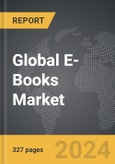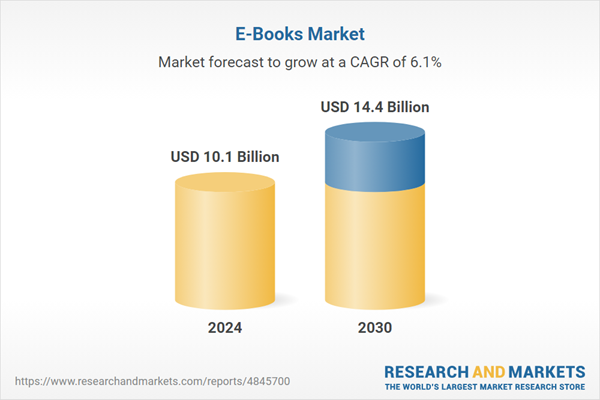Global E-Books Market - Key Trends and Drivers Summarized
How Have E-Books Transformed Reading Habits?
E-books have dramatically transformed reading habits, offering unprecedented convenience and accessibility. Unlike traditional print books, e-books can be stored on various devices such as e-readers, tablets, and smartphones, enabling readers to carry entire libraries in their pockets. This portability has made reading more flexible, allowing individuals to enjoy books during commutes, travels, or any idle moments. Additionally, e-books often come with adjustable font sizes, background lighting, and audio features, catering to diverse preferences and needs, including those of visually impaired readers. The instant availability of e-books through online stores and libraries means readers can access their desired books without the wait times associated with physical copies. This transformation has led to a significant increase in reading among younger generations, who are more inclined towards digital formats.What Are the Technological Innovations Driving the E-Book Market?
Technological innovations have been pivotal in driving the e-book market forward. The development of advanced e-readers like Amazon’s Kindle and Barnes & Noble’s Nook has revolutionized the e-book experience, offering features such as e-ink displays that mimic the look of paper and reduce eye strain. These devices often include built-in dictionaries, note-taking capabilities, and synchronization across multiple devices, enhancing the reading experience. Moreover, the integration of artificial intelligence in e-book platforms has enabled personalized recommendations, improving content discovery and reader engagement. Cloud storage solutions ensure that users can access their e-books from any device, promoting seamless reading continuity. Additionally, the rise of interactive e-books, which include multimedia elements like audio, video, and hyperlinks, has expanded the educational and entertainment possibilities of digital reading. These technological advancements have not only enhanced user experience but also broadened the appeal of e-books across different age groups and demographics.How Are Consumer Preferences Shaping the E-Book Industry?
Consumer preferences are significantly shaping the e-book industry, with a noticeable shift towards digital formats influenced by the convenience and cost-effectiveness they offer. The affordability of e-books compared to their print counterparts is a major draw, with frequent discounts and bundled offers available on digital platforms. Subscription services like Kindle Unlimited and Scribd provide readers with access to vast libraries for a monthly fee, catering to avid readers and contributing to the growing popularity of e-books. Furthermore, the trend of self-publishing has gained momentum, allowing authors to bypass traditional publishing routes and reach their audience directly through e-book platforms. This democratization of publishing has led to a proliferation of diverse content, catering to niche markets and specific reader interests. Consumer demand for immediate access to new releases and the ability to sample books before purchasing has also influenced the publishing strategies of major authors and publishers, who increasingly prioritize digital releases.What Factors Are Driving Growth in the E-Book Market?
The growth in the e-book market is driven by several factors. Technological advancements in e-readers and mobile devices have made e-books more accessible and enjoyable, encouraging adoption among tech-savvy readers. The convenience of purchasing and downloading books instantly from anywhere with an internet connection has also spurred growth. Changing consumer behavior, with a preference for digital over physical media due to space constraints and environmental concerns, is a significant driver. The rise of self-publishing platforms has empowered a new generation of authors, expanding the range of available content and appealing to diverse reader interests. Additionally, the integration of e-books in educational curriculums and corporate training programs has boosted demand in these sectors. Globalization and the availability of e-books in multiple languages have expanded the market's reach, while ongoing innovations, such as enhanced interactive features, continue to attract new readers. These factors collectively contribute to the robust growth trajectory of the e-book market, reflecting its evolving dynamics and expanding influence.Report Scope
The report analyzes the E-Books market, presented in terms of units. The analysis covers the key segments and geographic regions outlined below.Segments: Genre (Fiction, Nonfiction & Education, Literature, Children’s Book, Comics & Graphic Novels, Other Genres).
Geographic Regions/Countries: World; United States; Canada; Japan; China; Europe (France; Germany; Italy; United Kingdom; Spain; Russia; and Rest of Europe); Asia-Pacific (Australia; India; South Korea; and Rest of Asia-Pacific); Latin America (Argentina; Brazil; Mexico; and Rest of Latin America); Middle East (Iran; Israel; Saudi Arabia; United Arab Emirates; and Rest of Middle East); and Africa.
Key Insights:
- Market Growth: Understand the significant growth trajectory of the Fiction Genre segment, which is expected to reach US$5.1 Billion by 2030 with a CAGR of a 7.0%. The Nonfiction & Education Genre segment is also set to grow at 6.7% CAGR over the analysis period.
- Regional Analysis: Gain insights into the U.S. market, valued at $2.6 Billion in 2024, and China, forecasted to grow at an impressive 9.3% CAGR to reach $3.4 Billion by 2030. Discover growth trends in other key regions, including Japan, Canada, Germany, and the Asia-Pacific.
Why You Should Buy This Report:
- Detailed Market Analysis: Access a thorough analysis of the Global E-Books Market, covering all major geographic regions and market segments.
- Competitive Insights: Get an overview of the competitive landscape, including the market presence of major players across different geographies.
- Future Trends and Drivers: Understand the key trends and drivers shaping the future of the Global E-Books Market.
- Actionable Insights: Benefit from actionable insights that can help you identify new revenue opportunities and make strategic business decisions.
Key Questions Answered:
- How is the Global E-Books Market expected to evolve by 2030?
- What are the main drivers and restraints affecting the market?
- Which market segments will grow the most over the forecast period?
- How will market shares for different regions and segments change by 2030?
- Who are the leading players in the market, and what are their prospects?
Report Features:
- Comprehensive Market Data: Independent analysis of annual sales and market forecasts in US$ Million from 2024 to 2030.
- In-Depth Regional Analysis: Detailed insights into key markets, including the U.S., China, Japan, Canada, Europe, Asia-Pacific, Latin America, Middle East, and Africa.
- Company Profiles: Coverage of players such as Amazon.com, Inc., Astak, Inc., Bloomsbury Publishing Inc., Hachette Book Group, Inc., HarperCollins Publishers and more.
- Complimentary Updates: Receive free report updates for one year to keep you informed of the latest market developments.
Some of the 122 companies featured in this E-Books market report include:
- Amazon.com, Inc.
- Astak, Inc.
- Bloomsbury Publishing Inc.
- Hachette Book Group, Inc.
- HarperCollins Publishers
- Kensington Publishing Corp.
- Lulu Press, Inc.
- Microsoft Corporation
- Nokia Corporation
- Penguin Random House LLC
- Samsung Electronics Co., Ltd.
- Sony Corporation
- Tesco PLC
Tariff Impact Analysis: Key Insights for 2025
Global tariff negotiations across 180+ countries are reshaping supply chains, costs, and competitiveness. This report reflects the latest developments as of April 2025 and incorporates forward-looking insights into the market outlook.The analysts continuously track trade developments worldwide, drawing insights from leading global economists and over 200 industry and policy institutions, including think tanks, trade organizations, and national economic advisory bodies. This intelligence is integrated into forecasting models to provide timely, data-driven analysis of emerging risks and opportunities.
What’s Included in This Edition:
- Tariff-adjusted market forecasts by region and segment
- Analysis of cost and supply chain implications by sourcing and trade exposure
- Strategic insights into geographic shifts
Buyers receive a free July 2025 update with:
- Finalized tariff impacts and new trade agreement effects
- Updated projections reflecting global sourcing and cost shifts
- Expanded country-specific coverage across the industry
Table of Contents
Companies Mentioned (Partial List)
A selection of companies mentioned in this report includes, but is not limited to:
- Amazon.com, Inc.
- Astak, Inc.
- Bloomsbury Publishing Inc.
- Hachette Book Group, Inc.
- HarperCollins Publishers
- Kensington Publishing Corp.
- Lulu Press, Inc.
- Microsoft Corporation
- Nokia Corporation
- Penguin Random House LLC
- Samsung Electronics Co., Ltd.
- Sony Corporation
- Tesco PLC
Table Information
| Report Attribute | Details |
|---|---|
| No. of Pages | 327 |
| Published | April 2025 |
| Forecast Period | 2024 - 2030 |
| Estimated Market Value ( USD | $ 10.1 Billion |
| Forecasted Market Value ( USD | $ 14.4 Billion |
| Compound Annual Growth Rate | 6.1% |
| Regions Covered | Global |









